|
While perusing engineering and science magazines and websites, I often run across
photos of some really cool-looking RF devices that make me wish I had a use for
them, or at least had examples to put on display as conversation pieces. Usually
the components look the way they do purely due to functional necessity, but sometimes
I think the designers intentionally add a little bit of 'wow' factor to them. Waveguide
components tend to dominate. Here are few examples of what I mean. The
National Electronics
Museum, which often lends some of its items to the
MTT-S (IEEE's Microwave Theory and Techniques Society, aka IMS
- International Microwave Symposium) show, has a great collection of particularly
nifty specimens.
 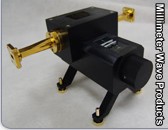 Sage
Millimeter has this
Space Qualified 26.8 GHz Integrated Transmitter Module (left)
in one of their current magazine advertisements. It is designed and manufactured
for small satellite applications. The horn antenna built onto the amplifier assembly
definitely looks spiffy. I want one for my curio cabinet of cool stuff. Sage
Millimeter has this
Space Qualified 26.8 GHz Integrated Transmitter Module (left)
in one of their current magazine advertisements. It is designed and manufactured
for small satellite applications. The horn antenna built onto the amplifier assembly
definitely looks spiffy. I want one for my curio cabinet of cool stuff.
I also saw some nifty
adjustable attenuators, including this one (right)
with legs from Millimeter Wave Products. It is an instrument grade precision attenuator.
The gold-plated waveguide 'ears' are the pièce de résistance.
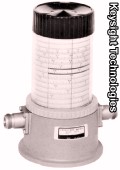 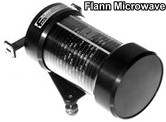 Who
wouldn't like to own one of these
Direct Reading Frequency Meters (right) made by Flann Microwave?
It uses a resonant cavity to somehow cause the rotating cylinder to indicate the
applied frequency to within 0.12% accuracy. Keysight Technologies, formerly Agilent
Technologies, formerly Hewlett-Packard, also makes a
coaxial frequency meter (left). According to
the application note from Keysight, "At resonance, power is absorbed by the cavity,
producing a dip in the coaxial line power." The details must be a closely held secret
in the industry because all of the attempts I made to access technical papers require
payment in cash or by registering with your e-mail and personal info. Who
wouldn't like to own one of these
Direct Reading Frequency Meters (right) made by Flann Microwave?
It uses a resonant cavity to somehow cause the rotating cylinder to indicate the
applied frequency to within 0.12% accuracy. Keysight Technologies, formerly Agilent
Technologies, formerly Hewlett-Packard, also makes a
coaxial frequency meter (left). According to
the application note from Keysight, "At resonance, power is absorbed by the cavity,
producing a dip in the coaxial line power." The details must be a closely held secret
in the industry because all of the attempts I made to access technical papers require
payment in cash or by registering with your e-mail and personal info.
 I swear something like
this from General Dynamics SATCOM's
Tracking
Feeds & Couplers product line appeared as a spaceship in an episode of
Star Wars, or maybe it was
Star Trek. It evidently is used in radar
tracking systems. Midnight blue paint would add an extra touch of glamor to it,
and would go well with a Flann frequency meter.. I swear something like
this from General Dynamics SATCOM's
Tracking
Feeds & Couplers product line appeared as a spaceship in an episode of
Star Wars, or maybe it was
Star Trek. It evidently is used in radar
tracking systems. Midnight blue paint would add an extra touch of glamor to it,
and would go well with a Flann frequency meter..
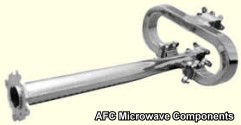 AFC Microwave Components'
Orthomode Coupler
may well be a copyright infringement on Dr. Seuss's Jing Tingler or maybe the Gar Ginker that appeared
in
How the Grinch Stole Christmas. My daughter,
Sally, who has a natural penchant for painting things in Seuss-like
color schemes, would do a nice job of enhancing its polished steel exterior. AFC Microwave Components'
Orthomode Coupler
may well be a copyright infringement on Dr. Seuss's Jing Tingler or maybe the Gar Ginker that appeared
in
How the Grinch Stole Christmas. My daughter,
Sally, who has a natural penchant for painting things in Seuss-like
color schemes, would do a nice job of enhancing its polished steel exterior.
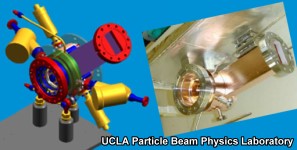 These two versions
of UCLA Particle Beam Physics Laboratory's "ORION version of the 1.6 cell RF photocathode
gun and related vacuum and waveguide components and ports" need to be displayed
side-by-side in my display case in order to profoundly demonstrate the correlation
between software models and physical models. A coat of clear lacquer would assure
a lasting sheen. These two versions
of UCLA Particle Beam Physics Laboratory's "ORION version of the 1.6 cell RF photocathode
gun and related vacuum and waveguide components and ports" need to be displayed
side-by-side in my display case in order to profoundly demonstrate the correlation
between software models and physical models. A coat of clear lacquer would assure
a lasting sheen.
 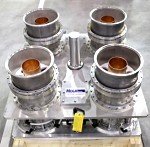 There is something innately
awesome about the contraptions built for waveguide - especially high power and high
frequency components. Nikoha, of Japan, has an entire catalog full such devices,
including this high power
waveguide circulator (left). There is something innately
awesome about the contraptions built for waveguide - especially high power and high
frequency components. Nikoha, of Japan, has an entire catalog full such devices,
including this high power
waveguide circulator (left).
This coaxial RF switch (right) by Mega Industries designed for use in the Fusion
Energy Division at Oak Ridge National Laboratory's 6 megawatt
US ITER nuclear fusion system (Iter = "The Way" in Latin).
I could spend hours looking for the things I've seen, but this took long enough.
Please send me your suggestions for additions to the page.
Posted February 19, 2015
|



































